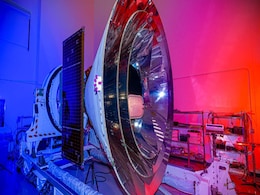Cosmic Formation
- All
- News
-

Did Black Hole Radiation Shape the Universe?
- Saturday March 29, 2025
- Written by Gadgets 360 Staff
A study suggests that Hawking radiation, first proposed by Stephen Hawking, may have influenced the universe’s structure. According to reports, primordial black holes that existed in the early universe could have evaporated through Hawking radiation, impacting matter distribution. The research explores how these black holes might have shaped gala...
-
 www.gadgets360.com
www.gadgets360.com
-

Smallest Galaxy Ever Found: Andromeda XXXV Defies Cosmic Evolution Models
- Thursday March 13, 2025
- Written by Gadgets 360 Staff
Astronomers have discovered Andromeda XXXV, the smallest and faintest known galaxy, located 3 million light-years away. It challenges existing models of galaxy formation, as similar small galaxies were thought to be destroyed in the early universe. Researchers are studying how it retained conditions for star formation despite harsh cosmic environme...
-
 www.gadgets360.com
www.gadgets360.com
-

Water May Have Formed in the Universe 100 Million Years After Big Bang
- Thursday March 13, 2025
- Written by Gadgets 360 Staff
A new study suggests water formed in the universe just 100–200 million years after the Big Bang, much earlier than previously estimated. Researchers examined ancient supernovas to understand how oxygen combined with hydrogen to create water. If confirmed, these findings could change perspectives on when the conditions for life first emerged. The ...
-
 www.gadgets360.com
www.gadgets360.com
-

Mysterious Planetary-Mass Objects May Form in Young Star System Clashes
- Wednesday March 12, 2025
- Written by Gadgets 360 Staff
Recent research challenges traditional views on planetary-mass objects, suggesting they may form through violent interactions between young star systems rather than standard planetary or stellar processes. Simulations indicate these clashes create dense gas filaments that evolve into free-floating objects, often in binary pairs. This discovery expl...
-
 www.gadgets360.com
www.gadgets360.com
-

Hubble Captures Stunning Tarantula Nebula Image, Revealing Cosmic Dust and Star Formation
- Thursday February 27, 2025
- Written by Gadgets 360 Staff
A new image from the Hubble Space Telescope highlights the Tarantula Nebula’s complex structure, featuring dense cosmic dust clouds and vibrant star-forming regions. This nebula, located 160,000 light-years away, plays a vital role in understanding stellar evolution. The captured details offer insights into how cosmic dust contributes to star and...
-
 www.gadgets360.com
www.gadgets360.com
-

Hubble’s New Image of Tarantula Nebula Showcases Cosmic Dust and Star Formation
- Tuesday February 18, 2025
- Written by Gadgets 360 Staff
NASA/ESA’s Hubble Space Telescope has captured a breathtaking image of the Tarantula Nebula, located 160,000 light-years away in the Large Magellanic Cloud. The image reveals intricate cosmic dust patterns and active star formation, offering valuable insights into the role of interstellar material in stellar evolution. Researchers are using the d...
-
 www.gadgets360.com
www.gadgets360.com
-

SPHEREx Space Telescope to Map Cosmos in Infrared Light, Launching in February 2025
- Tuesday February 4, 2025
- Written by Gadgets 360 Staff
Set to launch in February 2025, NASA’s SPHEREx mission will provide a comprehensive map of the universe in infrared light. The telescope will examine 450 million galaxies and 100 million stars, shedding light on the universe’s formation, early conditions after the Big Bang, and the presence of water in planetary systems. SPHEREx will survey the...
-
 www.gadgets360.com
www.gadgets360.com
-

JWST Detects Unexpectedly Massive Black Holes in the Early Universe
- Monday February 3, 2025
- Written by Gadgets 360 Staff
A new study led by Jorryt Matthee of ISTA reveals that black holes in early galaxies were significantly more massive than expected. Using JWST data, researchers found that some black holes accounted for nearly 10% of their galaxy's stellar mass—far exceeding the 0.01% ratio seen in modern galaxies. The findings challenge existing growth models, s...
-
 www.gadgets360.com
www.gadgets360.com
-

Gravitational Waves Reveal Black Hole Ancestry Through Spin Analysis
- Monday February 3, 2025
- Written by Gadgets 360 Staff
A study published in Physical Review Letters explores how gravitational waves reveal the ancestry of black holes. By examining 69 black hole mergers, researchers found that spin shifts indicate repeated collisions in dense star clusters. This insight supports models suggesting black holes grow through sequential mergers. Observatories like LIGO and...
-
 www.gadgets360.com
www.gadgets360.com
-

Researchers Spot Unusual, Overmassive Globular Clusters in Ultra-Diffuse Galaxy FCC 224
- Friday January 31, 2025
- Written by Gadgets 360 Staff
A new study has uncovered an unexpected globular cluster system in FCC 224, an ultra-diffuse galaxy located in the Fornax cluster. Using data from the Hubble Space Telescope and the Keck Cosmic Web Imager, researchers found that FCC 224 hosts luminous, overmassive globular clusters with unusual properties. The galaxy’s star clusters exhibit narro...
-
 www.gadgets360.com
www.gadgets360.com
-

NASA SPHEREx Telescope to Map the Universe and Search for Life’s Ingredients
- Thursday January 30, 2025
- Written by Gadgets 360 Staff
NASA’s SPHEREx mission, set to launch aboard a SpaceX Falcon 9 rocket on February 27, aims to explore the origins of the universe and the formation of galaxies. Using near-infrared light, the telescope will study over 450 million galaxies and 100 million stars in the Milky Way. It will also search for water and organic molecules in regions where ...
-
 www.gadgets360.com
www.gadgets360.com
-

Early Supernovas Could Have Created Water in the Universe, Paving the Way for Life 100 Million Years Post-Big Bang
- Friday January 24, 2025
- Written by Gadgets 360 Staff
A recent study suggests that supernova explosions, triggered by the death of early stars, could have created significant amounts of water just 100 million years after the Big Bang. Simulations of these early, massive stars show that their explosive deaths may have resulted in the formation of water molecules within the dense hydrogen and oxygen clo...
-
 www.gadgets360.com
www.gadgets360.com
-

Astronomers Spot Hundreds of Hidden Supermassive Black Holes Using Infrared
- Tuesday January 21, 2025
- Written by Gadgets 360 Staff
Hundreds of hidden supermassive black holes have been identified using infrared observations, offering fresh insights into their role in galaxy formation. Researchers relied on data from NASA's Infrared Astronomical Satellite (IRAS) and the Nuclear Spectroscopic Telescope Array (NuSTAR) to detect emissions from black holes obscured by thick clouds ...
-
 www.gadgets360.com
www.gadgets360.com
-

Astronomers Observe Black Hole Reactivate, Emitting Jets of Plasma
- Monday January 20, 2025
- Written by Gadgets 360 Staff
A supermassive black hole at the center of galaxy 1ES 1927+654 has been observed reactivating after a quiet period. Jets of hot gas were released from both sides of the black hole, surprising astronomers. Researchers speculate that a white dwarf star in close orbit may be interacting with the black hole, providing key insights into cosmic behavior....
-
 www.gadgets360.com
www.gadgets360.com
-

Cosmic Rays Could Help Scientists Study Tornado Formation Through Muon Detection
- Monday January 13, 2025
- Written by Gadgets 360 Staff
Cosmic rays and their byproduct, muons, may help scientists study tornado formation by detecting pressure changes remotely. This technique would avoid the need for direct measurements within dangerous storms. Researchers plan to use muon detectors over large areas or portable versions to track severe weather patterns. The findings could enhance und...
-
 www.gadgets360.com
www.gadgets360.com
-

Did Black Hole Radiation Shape the Universe?
- Saturday March 29, 2025
- Written by Gadgets 360 Staff
A study suggests that Hawking radiation, first proposed by Stephen Hawking, may have influenced the universe’s structure. According to reports, primordial black holes that existed in the early universe could have evaporated through Hawking radiation, impacting matter distribution. The research explores how these black holes might have shaped gala...
-
 www.gadgets360.com
www.gadgets360.com
-

Smallest Galaxy Ever Found: Andromeda XXXV Defies Cosmic Evolution Models
- Thursday March 13, 2025
- Written by Gadgets 360 Staff
Astronomers have discovered Andromeda XXXV, the smallest and faintest known galaxy, located 3 million light-years away. It challenges existing models of galaxy formation, as similar small galaxies were thought to be destroyed in the early universe. Researchers are studying how it retained conditions for star formation despite harsh cosmic environme...
-
 www.gadgets360.com
www.gadgets360.com
-

Water May Have Formed in the Universe 100 Million Years After Big Bang
- Thursday March 13, 2025
- Written by Gadgets 360 Staff
A new study suggests water formed in the universe just 100–200 million years after the Big Bang, much earlier than previously estimated. Researchers examined ancient supernovas to understand how oxygen combined with hydrogen to create water. If confirmed, these findings could change perspectives on when the conditions for life first emerged. The ...
-
 www.gadgets360.com
www.gadgets360.com
-

Mysterious Planetary-Mass Objects May Form in Young Star System Clashes
- Wednesday March 12, 2025
- Written by Gadgets 360 Staff
Recent research challenges traditional views on planetary-mass objects, suggesting they may form through violent interactions between young star systems rather than standard planetary or stellar processes. Simulations indicate these clashes create dense gas filaments that evolve into free-floating objects, often in binary pairs. This discovery expl...
-
 www.gadgets360.com
www.gadgets360.com
-

Hubble Captures Stunning Tarantula Nebula Image, Revealing Cosmic Dust and Star Formation
- Thursday February 27, 2025
- Written by Gadgets 360 Staff
A new image from the Hubble Space Telescope highlights the Tarantula Nebula’s complex structure, featuring dense cosmic dust clouds and vibrant star-forming regions. This nebula, located 160,000 light-years away, plays a vital role in understanding stellar evolution. The captured details offer insights into how cosmic dust contributes to star and...
-
 www.gadgets360.com
www.gadgets360.com
-

Hubble’s New Image of Tarantula Nebula Showcases Cosmic Dust and Star Formation
- Tuesday February 18, 2025
- Written by Gadgets 360 Staff
NASA/ESA’s Hubble Space Telescope has captured a breathtaking image of the Tarantula Nebula, located 160,000 light-years away in the Large Magellanic Cloud. The image reveals intricate cosmic dust patterns and active star formation, offering valuable insights into the role of interstellar material in stellar evolution. Researchers are using the d...
-
 www.gadgets360.com
www.gadgets360.com
-

SPHEREx Space Telescope to Map Cosmos in Infrared Light, Launching in February 2025
- Tuesday February 4, 2025
- Written by Gadgets 360 Staff
Set to launch in February 2025, NASA’s SPHEREx mission will provide a comprehensive map of the universe in infrared light. The telescope will examine 450 million galaxies and 100 million stars, shedding light on the universe’s formation, early conditions after the Big Bang, and the presence of water in planetary systems. SPHEREx will survey the...
-
 www.gadgets360.com
www.gadgets360.com
-

JWST Detects Unexpectedly Massive Black Holes in the Early Universe
- Monday February 3, 2025
- Written by Gadgets 360 Staff
A new study led by Jorryt Matthee of ISTA reveals that black holes in early galaxies were significantly more massive than expected. Using JWST data, researchers found that some black holes accounted for nearly 10% of their galaxy's stellar mass—far exceeding the 0.01% ratio seen in modern galaxies. The findings challenge existing growth models, s...
-
 www.gadgets360.com
www.gadgets360.com
-

Gravitational Waves Reveal Black Hole Ancestry Through Spin Analysis
- Monday February 3, 2025
- Written by Gadgets 360 Staff
A study published in Physical Review Letters explores how gravitational waves reveal the ancestry of black holes. By examining 69 black hole mergers, researchers found that spin shifts indicate repeated collisions in dense star clusters. This insight supports models suggesting black holes grow through sequential mergers. Observatories like LIGO and...
-
 www.gadgets360.com
www.gadgets360.com
-

Researchers Spot Unusual, Overmassive Globular Clusters in Ultra-Diffuse Galaxy FCC 224
- Friday January 31, 2025
- Written by Gadgets 360 Staff
A new study has uncovered an unexpected globular cluster system in FCC 224, an ultra-diffuse galaxy located in the Fornax cluster. Using data from the Hubble Space Telescope and the Keck Cosmic Web Imager, researchers found that FCC 224 hosts luminous, overmassive globular clusters with unusual properties. The galaxy’s star clusters exhibit narro...
-
 www.gadgets360.com
www.gadgets360.com
-

NASA SPHEREx Telescope to Map the Universe and Search for Life’s Ingredients
- Thursday January 30, 2025
- Written by Gadgets 360 Staff
NASA’s SPHEREx mission, set to launch aboard a SpaceX Falcon 9 rocket on February 27, aims to explore the origins of the universe and the formation of galaxies. Using near-infrared light, the telescope will study over 450 million galaxies and 100 million stars in the Milky Way. It will also search for water and organic molecules in regions where ...
-
 www.gadgets360.com
www.gadgets360.com
-

Early Supernovas Could Have Created Water in the Universe, Paving the Way for Life 100 Million Years Post-Big Bang
- Friday January 24, 2025
- Written by Gadgets 360 Staff
A recent study suggests that supernova explosions, triggered by the death of early stars, could have created significant amounts of water just 100 million years after the Big Bang. Simulations of these early, massive stars show that their explosive deaths may have resulted in the formation of water molecules within the dense hydrogen and oxygen clo...
-
 www.gadgets360.com
www.gadgets360.com
-

Astronomers Spot Hundreds of Hidden Supermassive Black Holes Using Infrared
- Tuesday January 21, 2025
- Written by Gadgets 360 Staff
Hundreds of hidden supermassive black holes have been identified using infrared observations, offering fresh insights into their role in galaxy formation. Researchers relied on data from NASA's Infrared Astronomical Satellite (IRAS) and the Nuclear Spectroscopic Telescope Array (NuSTAR) to detect emissions from black holes obscured by thick clouds ...
-
 www.gadgets360.com
www.gadgets360.com
-

Astronomers Observe Black Hole Reactivate, Emitting Jets of Plasma
- Monday January 20, 2025
- Written by Gadgets 360 Staff
A supermassive black hole at the center of galaxy 1ES 1927+654 has been observed reactivating after a quiet period. Jets of hot gas were released from both sides of the black hole, surprising astronomers. Researchers speculate that a white dwarf star in close orbit may be interacting with the black hole, providing key insights into cosmic behavior....
-
 www.gadgets360.com
www.gadgets360.com
-

Cosmic Rays Could Help Scientists Study Tornado Formation Through Muon Detection
- Monday January 13, 2025
- Written by Gadgets 360 Staff
Cosmic rays and their byproduct, muons, may help scientists study tornado formation by detecting pressure changes remotely. This technique would avoid the need for direct measurements within dangerous storms. Researchers plan to use muon detectors over large areas or portable versions to track severe weather patterns. The findings could enhance und...
-
 www.gadgets360.com
www.gadgets360.com
















